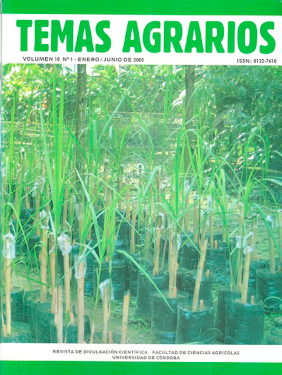Characterization of essential oil of swinglea lemon (Swinglea glutinosa) peel for GC-me
Caracterización del aceite esencial en la corteza del limón Swinglea (Swinglea glutinosa) por CG/EM

This work is licensed under a Creative Commons Attribution-NonCommercial 4.0 International License.
Show authors biography
For the extraction and analysis of the essential oil of the peel of Swinglea glutinosa lemon fruits were chosen with a maturity index between 3.73 and 8.83. The peel was processed, mix et with ethanol solution (5%) and hydro-distillate et for 2 hours; yields between 0.20 and 0.39% were obtained. The volatile constituents were analyzed by means of Gas Chromatography and Mass Spectrometry (GC-MS). 14 components were identified among them β-Cubebene (26.48-28.74%), β-Pinene (24.19-28.83%), Elixene (10.13-11.03%), β-Caryophillene (6.30-9.55%), β-Phellandrene (5.99-7.86%), α-Pinene (4.44- 6.67%), D-Limonene (4.45-5.38%) and Anozol (1.45-4.38%) were abundant. The identification of some of the constituents was done by mass spectra comparison with those of the database (NIST 98 version 2.0) and others by matching the retention times with pure samples under the same experimental conditions.
Article visits 6300 | PDF visits
Downloads
- Blanco, C.; Grane, N. y Nieto, M. 1995. Comparative study of Colombian citrus oils by high-resolution gas chromatography and gas chromatography-mass spectrometry. Journal of Chromatography 697:501 – 513.
- Braddock, R. 1999. Handbook of Citrus. Products and Processing Technology. Editorial Wiley, New York, p.247- 256.
- Caccioni M. 1998. Relationship between volatile components of citrus fruit essential oils and antimicrobial action on Penicillium digitatum and Penicillium italicum. International Journal of Food Microbiology 43:73– 79
- Correa, G.; Gómez, M. y Rojo, A. 1999. Desarrollo experimental de una unidad piloto para la extracción de aceite esencial de manzanilla. Tesis Ingeniero Químico, Universidad Pontificia Bolivariana (Medellín), 149 p.
- Dreyer, D. 1970. Extractives of Swinglea glutinosa (bl.) Merr. Tetrahedron Journal 26 (24):5745-5751.
- Lota, M.; Serra R.; Tomi, F. y Casanova, J. 2002. Variability of peel and leaf essential oils from Citrus reticulata Blanco. Journal Biochemical Systematic and Ecology Chemical 28:61–78
- Minh, T.; Li, P. y Tao, N. 2002. Characteristic odor components of Citrus Shaerocarpa Tanaka (Kabosu) coldpressed peel oil. Journal of Agricultural and Food Chemistry 50:2908–2913.
- Pérez, E. 1956. Plantas útiles de Colombia. Camacho Roldan Ltda, Bogota, 590p.
- Stashenko, E.; Martínez, R.; Pinzón, H. y Ramírez. J. 1996. Journal of Chromatography A, 752:217-222
- Sawanura, M.; Son, U.; Choi H.; Kim, M.; Phi, N.; Fears, M. y Kumagai, C. 2004. Compositional changes in commercial lemon essential oil for aromatherapy. International Journal of Aromatherapy, 14:346-368
- Velasquez, E. y Zuluaga, O. 1997. Diseño de un proceso industrial para la obtención de aceites esenciales de dos especies nativas colombianas bajo la filosofía de cero emisiones. Tesis Ingeniero Industrial, Universidad EAFIT, Medellín, 178p
- Weniger, M. 2001. Bioactive Acridone Alkaloids from Swinglea glutinosa. Journal of Natural Products 64:1221– 1223




















